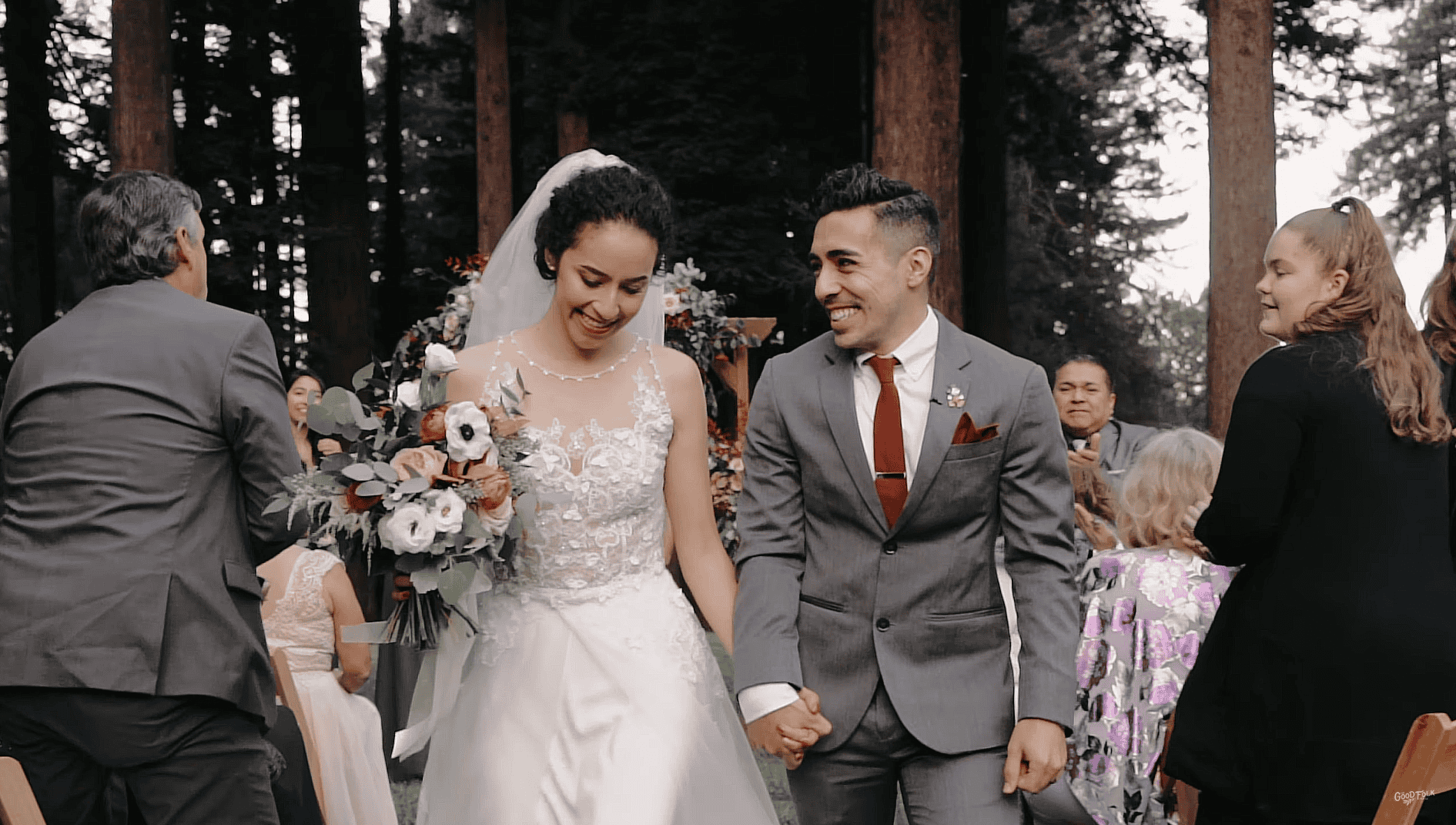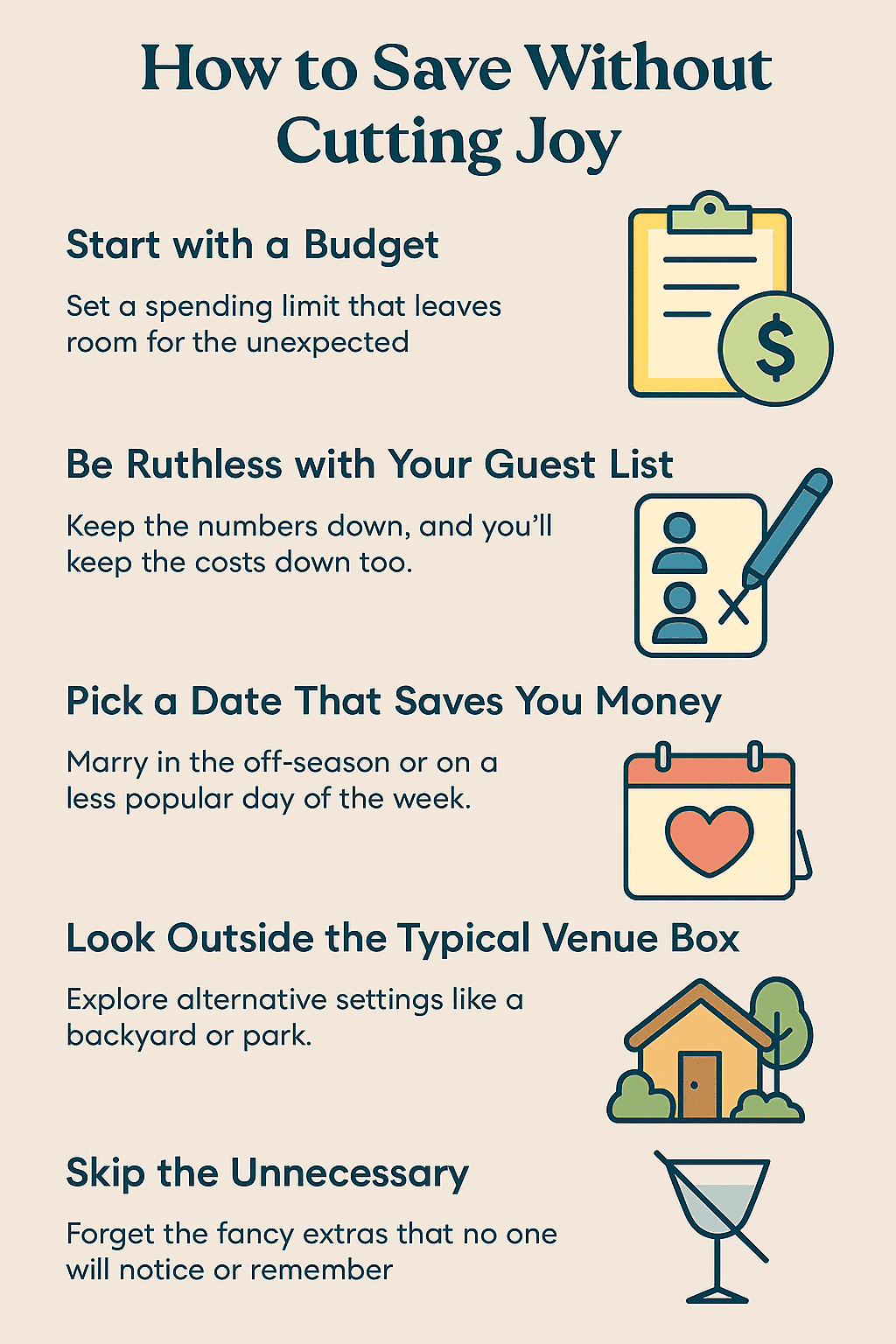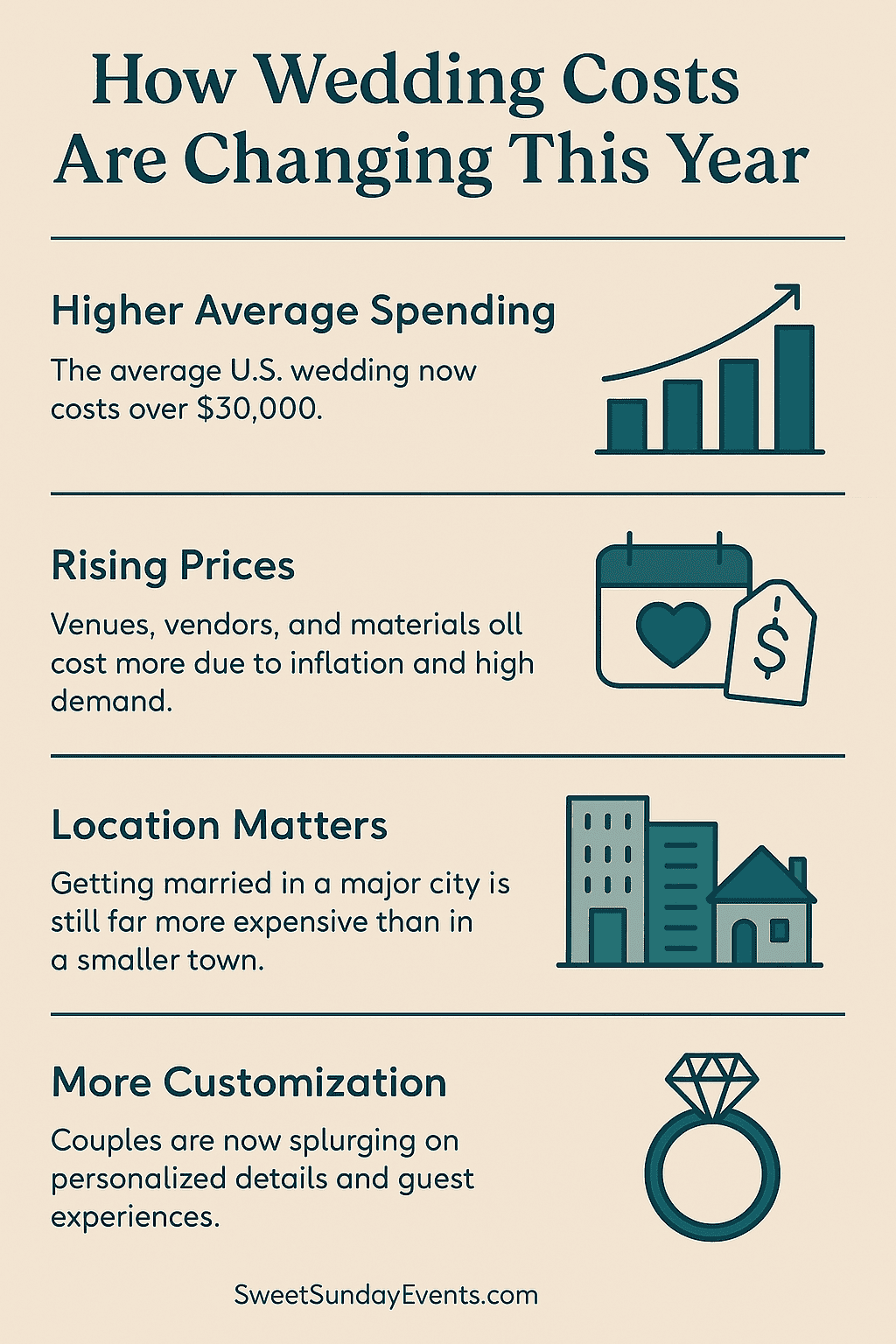Planning a wedding in 2025? Welcome to a world where the bouquet isn’t the only thing blooming—so are the prices. Whether you’re working with a big budget or keeping things tight, wedding planning this year looks a little different than it used to.
It’s not just because cakes now have their own social media managers (kidding…sort of). The entire wedding economy has been shifting under our feet, and couples across the U.S. are feeling it.
What’s changing? Pretty much everything—prices, expectations, how vendors operate, and the kinds of events couples want to host. It’s a swirl of tradition and modernity, Pinterest boards and spreadsheets, all colliding under a “we want our wedding to feel like us” mindset. Sound familiar?
This isn’t a crisis. It’s just a recalibration. If you know what to expect, and you know where the money goes, you’ll have a better shot at building something that fits your vision—and still lets you sleep at night.
How Much Are Couples Spending?
The average cost of a wedding in the U.S. this year? Around $36,000, according to Zola’s 2025 First Look Report. That’s not a typo. The average is continuing to edge up from previous years: $35,000 in 2023, $30,000 in 2022, and closer to $27,000 back in 2019. That’s a $9,000 increase in just six years.
But here’s the thing—those are averages, not the rule. Half of all weddings in the U.S. happen on a median budget of around $10,000. The $36,000 figure includes couples who spend $100,000 or more, which skews everything upwards. That said, mid-range weddings have crept up too. It’s not just high-end events pulling that number north.
So while not everyone’s shelling out the equivalent of a luxury SUV, even modest weddings cost more than they did a few years ago. The question is why—and what to do about it.
Why Weddings Are More Expensive Now
The short answer? A tangled knot of inflation, demand, and higher expectations. It’s not one single factor—it’s the sum of a dozen decisions.
In 2020 and 2021, thousands of weddings were postponed or canceled. Once the world opened up again, couples scrambled to rebook. Venues and vendors were overwhelmed, and many raised their rates. It wasn’t price gouging—it was survival. Labor shortages, supply chain issues, and increased costs for food, fuel, and flowers meant that everyone, from the DJ to the cake baker, had to charge more just to break even.
Now, even with the wedding boom settling down, those costs haven’t dropped. Inflation is sticky. And couples are walking into a market where pricing is built around 2021’s demand, not pre-pandemic norms.
Then there’s the expectations piece. Pinterest-worthy setups, custom everything, multi-day wedding weekends—it adds up. Couples are investing more in personalization and guest experience, and the industry has evolved to meet that demand with premium options at nearly every turn.
And yes, some of it is just plain lifestyle creep. When everyone around you seems to be having a curated wedding with calligraphy place cards and a neon photo wall, suddenly you start to wonder if your own day should have that too.
We’ll go deeper on where the actual dollars are going in the next section.
Regional Differences: Where You Get Married Matters
Planning your wedding in New York City? Budget for sticker shock. Saying “I do” in a small Midwestern town? Your wallet will breathe a little easier. Where you marry makes a massive difference—not just for the venue, but across the board.
Couples getting married in high-cost metros like NYC, Los Angeles, or San Francisco routinely face average budgets of $50,000–$60,000 or more. Venues alone can run $15,000 or higher. In those cities, even “standard” packages come with premium price tags thanks to high labor costs, strong vendor demand, and very little wiggle room.
In contrast, states like Utah, Idaho, and Mississippi often report average wedding budgets closer to $15,000–$20,000. You can still throw a gorgeous party in those places—it just might be on a ranch, in a state park, or at a local lodge rather than a hotel rooftop.
Even within states, city vs. rural makes a difference. A barn venue 40 miles outside Chicago will be priced very differently than a ballroom in downtown Chicago. Suburban weddings tend to be less expensive across almost every line item—venue, vendor fees, taxes, you name it.
And don’t forget guest cost considerations: venues in major cities often require guests to spend more on lodging and transportation, which can influence your decisions around things like welcome events or shuttle buses.
Bottom line? Location doesn’t just set the vibe—it sets the pricing ceiling, too.
What’s Eating the Budget?
If your wedding budget feels like it’s vanishing faster than champagne on a July afternoon, you’re not alone. Here’s where the bulk of the money tends to go—and why these areas are feeling steeper in 2025.
Venue and Catering
These two combined are typically the biggest slice of the pie. Venue rentals have gone up thanks to staffing shortages and general demand. In 2023, the average venue cost was around $12,800, and that number continues to grow in dense metro areas. Throw in catering at $100 per guest, and you’re looking at $10,000+ for 100 people, just for food.
Even couples choosing more casual formats (like cocktail-style receptions) are running into high food and beverage minimums. The era of “cheap buffet and fold-out chairs” is long gone—unless you’re hosting at home and doing the cooking yourself.
Photography and Videography
Capturing the day is non-negotiable for most couples, and rates reflect that. The average wedding photographer charges between $2,500 and $4,000 depending on location and package. Videographers are often another $2,000 on top of that.
Some couples are trimming this category by hiring one pro for both, or shortening the coverage window. But most agree this is one place where skimping can lead to regrets. You’re not just paying for someone to show up with a camera—you’re paying for their editing style, reliability, and ability to capture moments you didn’t even realize were happening.
Music and Entertainment
The party doesn’t start until the music plays—and that comes with its own price tag. DJs usually range between $1,200 and $2,000 in most parts of the country, while live bands start around $4,000 and can skyrocket well beyond $8,000 depending on the group and location.
Couples who care deeply about setting a specific mood tend to spend more here. A full jazz quartet for cocktail hour followed by a dance floor-filling band? It’s magical, yes, but it’s also money. That said, plenty of people opt for a killer DJ and a great playlist, and guests won’t notice the difference unless they’re very into trumpet solos.
Attire and Rings
Engagement rings continue to hover around a national average of $5,500, although there’s a growing trend toward lab-grown diamonds and alternative stones to save money (and align with sustainability values). Wedding bands for both partners can tack on another $500–$2,000 combined, depending on the material and design.
Wedding attire is its own universe. Brides spend an average of $1,800–$2,500 on a dress, with many going higher for designer labels. Grooms’ suits or tuxedos can be rented for under $300, or purchased for $500–$1,000. Tailoring is a hidden cost people forget to budget for—but it’s crucial if you want to look sharp instead of “trying your best.”
Florals and Decor
Fresh flowers don’t come cheap, and in 2025 they’ve been hit hard by climate changes in key growing regions and supply chain hiccups. Couples report spending between $2,000 and $4,000 on bouquets, centerpieces, ceremony flowers, and installations. Larger floral moments—think hanging chandeliers or floral arches—can add thousands more.
As for decor, prices vary wildly. Some couples spend just a few hundred on candles and signage; others go all out with draping, uplighting, lounge furniture, and more. Many planners suggest budgeting 8–12% of your total spend for decor if aesthetics are a major priority. Renting from companies like Hatch or local event rental firms can help keep things visually polished without owning 27 lanterns afterward.
Planners and Coordinators
More couples are hiring professional planners in 2025 than ever before. Why? Because life is busy, weddings are complex, and vendors book up fast. A full-service planner can cost $4,000–$10,000+, but partial or “month-of” coordination packages usually start around $1,500–$2,500.
Hiring a planner isn’t just about convenience. They often help couples save money through vendor referrals and package deals. And when things go wrong (as they sometimes do), a seasoned planner is worth their weight in gold. Think of it as investing in your own sanity.
Other Sneaky Costs
The wedding industrial complex is full of surprises. Budget for:
Stationery: Save-the-dates, invites, programs, menus, signage, and thank-you cards. Even going semi-custom can cost $500–$800 or more, especially once you add in postage. Many are opting for paperless options via sites like Greenvelope.
Beauty: Hair and makeup for the couple (and often the wedding party) adds up. Expect $150–$300 per person for each service. And yes, you’ll be expected to tip.
Transportation: Shuttles, limos, or party buses for the wedding party and guests. Depending on your location and timeline, this could be $600 or $2,000. Pro tip: some couples now negotiate shuttle services directly with hotel blocks.
Tips and gratuities: Many people forget to include this in the budget. Photographers, stylists, servers, DJs—most expect some kind of tip, and it’s often not built into the contract. Create a tip envelope system ahead of time to avoid scrambling on the day of.
Destination Weddings: Higher or Lower Cost?
You’d think flying off to a tropical beach would cost less than renting a ballroom downtown. And in some cases, that’s true. But more often than not, destination weddings turn out to be a tradeoff—not necessarily a bargain.
On paper, you save by trimming the guest list. Most destination weddings cap out around 40–80 guests, with many closer to 20. That cuts your food, drink, and seating costs dramatically. Venues like all-inclusive resorts often offer packages that bundle catering, flowers, and coordination for $10,000–$15,000, and you get a honeymoon thrown in. Sounds good, right?
But many couples wind up spending more anyway. Welcome parties, group excursions, extra nights at the resort, travel perks for family—it adds up fast. According to Zola, destination wedding couples in 2024 and 2025 are spending an average of $41,000, compared to ~$34,000 for non-destination weddings. In other words, it’s not always cheaper—it’s just differently expensive.
Still, destination weddings offer unique perks: more time with your guests, built-in scenery, and usually a more relaxed vibe. Just make sure your guests can afford the airfare and hotel stays, or you’ll find yourself celebrating with a much smaller group than expected.
How to Save Without Cutting Joy
SweetSundayEvents.comStart With a Budget That Has Breathing Room
Set your ceiling before you start shopping for venues or dresses. No really—write down your actual number and then reduce it by 10%. That smaller number? That’s your working budget. Because something unexpected will come up (it always does). Whether it’s rental minimums or tips you forgot to calculate, having a cushion will make things easier when your dream florist ends up costing $500 more than expected.
Tools from Zola or The Knot help you estimate vendor costs, but don’t rely on percentages alone. If a planner tells you to budget 8% for flowers, but florals matter way more to you than the cake, it’s okay to swap those numbers. A flexible budget is more useful than a rigid one—and a lot less stressful.
Be Ruthless With Your Guest List
It sounds cold, but fewer people = lower cost. This is the lever you can pull that affects everything. Every single guest adds money: another chair, another plate, another favor, another drink. Cut 20 guests, and you could save $3,000+ without losing anything except a few second cousins you haven’t seen since 2009.
Some couples are also doing “ceremony only” or “party only” guest lists. Intimate ceremony with close family, then a bigger bash later—or vice versa. No one is offended if you’re honest about your intentions, especially these days.
Pick a Date That Saves You Money
Saturdays in September? Priciest time of the year. Thursdays in February? Steep discounts. If you’re flexible on the calendar, ask venues about off-peak pricing. Sunday brunch weddings are becoming a trend for a reason—they cost less, feel more relaxed, and let guests get home before work the next day.
You don’t have to do an “off-season” wedding in the snow unless you want to, but spring Fridays or early fall Sundays are sweet spots. You can also trim vendor costs if they’re available midweek—planners and DJs especially may cut deals for non-peak days.
Look Outside the Typical Venue Box
Event halls, barns, and hotels have built-in pricing—but there are other options. Backyard weddings, community gardens, national parks, even chic restaurant buyouts can save you money and feel more personal.
Some couples are getting creative with Airbnb properties (just make sure to check the host’s rules) or choosing city-owned spaces that allow weddings for a small permit fee. These types of venues often mean you’ll need to bring in more rentals, but you have way more control over the vibe—and potentially the bill.
Skip the Unnecessary (Whatever That Means for You)
No one needs chair covers. No one remembers charger plates. No one talks about whether your programs were printed on handmade cotton paper or regular cardstock.
Wedding spending is emotional—every detail feels important. But the truth? Guests remember the food, the music, and how you made them feel. If something doesn’t matter to you, don’t spend money on it just because “everyone does.” Want pizza and pie instead of filet mignon and cake? Do it. Love a courthouse ceremony and a backyard BBQ? That’s still a wedding.
A Reflection of Changing Values in 2025
Personalization Over Perfection
One major shift we’ve seen is couples caring less about traditions for tradition’s sake and more about whether those traditions feel like them. Unity candles? Maybe. Whiskey blending ceremony? Even better. “Walking down the aisle” might mean a couple entering together, or skipping the aisle entirely. There’s a loosening of rules in the best way.
Instead of cookie-cutter timelines and aesthetics, weddings in 2025 are about individuality. One couple might exchange vows at sunrise barefoot on a hilltop; another might host a multi-course dinner party in an art gallery with zero dancing. The pressure to have a picture-perfect wedding has taken a backseat to having an experience that feels genuine, emotional, and joyful.
The Rise of Eco-Conscious and Minimalist Celebrations
Environmental awareness continues to play a bigger role in how couples plan. Digital invitations from platforms like Greenvelope are standard now. Many couples are choosing smaller local vendors, thrifted or rented décor, and opting out of single-use everything. It’s not about being trendy—it’s about being thoughtful.
Minimalist weddings don’t mean boring. They’re often the most elegant. Clean lines, meaningful music, food that’s actually good, and a ceremony that feels intentional. Couples are downsizing their guest lists not just to save, but because they want to have real conversations with every person there.
One Last Thought (But Not a Farewell)
The wedding world in 2025 is full of contradictions. Prices are rising, yet couples are finding creative ways to make magic happen on all kinds of budgets. Trends are faster than ever, but what’s standing out is what’s timeless: honesty, connection, laughter, and maybe some tears (the good kind).
Whether your wedding costs $5,000 or $75,000, the goal isn’t to impress—it’s to feel. To mark a moment. To say, “This is us,” and mean it. That’s something money can’t buy, and why it’s okay if not everything goes perfectly.
Because the best weddings aren’t perfect. They’re personal.





